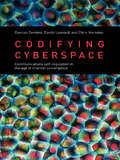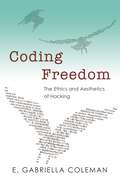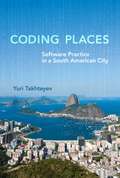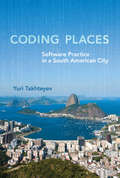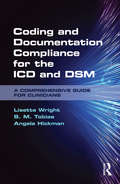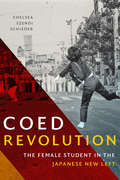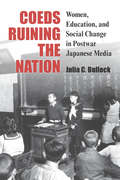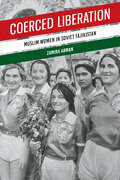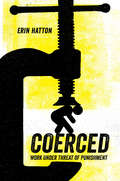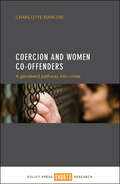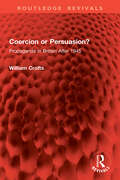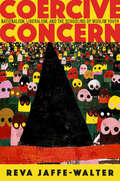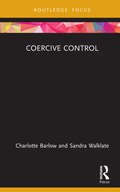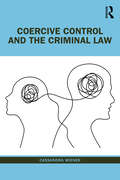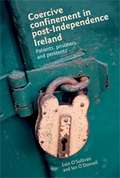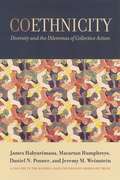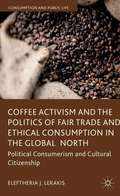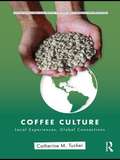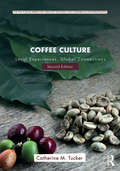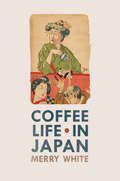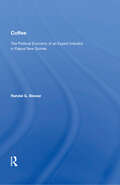- Table View
- List View
Codifying Cyberspace: Communications Self-Regulation in the Age of Internet Convergence
by Damian Tambini Danilo Leonardi Chris MarsdenCan the Internet regulate itself? Faced with a range of 'harms' and conflicts associated with the new media – from gambling to pornography – many governments have resisted the temptation to regulate, opting instead to encourage media providers to develop codes of conduct and technical measures to regulate themselves. Codifying Cyberspace looks at media self-regulation in practice, in a variety of countries. It also examines the problems of balancing private censorship against fundamental rights to freedom of expression and privacy for media users. This book is the first full-scale study of self-regulation and codes of conduct in these fast-moving new media sectors and is the result of a three-year Oxford University study funded by the European Commission.
Coding Freedom: The Ethics and Aesthetics of Hacking
by E. Gabriella ColemanWho are computer hackers? What is free software? And what does the emergence of a community dedicated to the production of free and open source software--and to hacking as a technical, aesthetic, and moral project--reveal about the values of contemporary liberalism? Exploring the rise and political significance of the free and open source software (F/OSS) movement in the United States and Europe, Coding Freedom details the ethics behind hackers' devotion to F/OSS, the social codes that guide its production, and the political struggles through which hackers question the scope and direction of copyright and patent law. In telling the story of the F/OSS movement, the book unfolds a broader narrative involving computing, the politics of access, and intellectual property. E. Gabriella Coleman tracks the ways in which hackers collaborate and examines passionate manifestos, hacker humor, free software project governance, and festive hacker conferences. Looking at the ways that hackers sustain their productive freedom, Coleman shows that these activists, driven by a commitment to their work, reformulate key ideals including free speech, transparency, and meritocracy, and refuse restrictive intellectual protections. Coleman demonstrates how hacking, so often marginalized or misunderstood, sheds light on the continuing relevance of liberalism in online collaboration.
Coding Places
by Yuri TakhteyevSoftware development would seem to be a quintessential example of today's Internet-enabled "knowledge work"--a global profession not bound by the constraints of geography. In Coding Places, Yuri Takhteyev looks at the work of software developers who inhabit two contexts: a geographical area--in this case, greater Rio de Janeiro--and a "world of practice," a global system of activities linked by shared meanings and joint practice. The work of the Brazilian developers, Takhteyev discovers, reveals a paradox of the world of software: it is both diffuse and sharply centralized. The world of software revolves around a handful of places--in particular, the San Francisco Bay area--that exercise substantial control over both the material and cultural elements of software production. Takhteyev shows how in this context Brazilian software developers work to find their place in the world of software and to bring its benefits to their city. Takhteyev's study closely examines Lua, an open source programming language developed in Rio but used in such internationally popular products as World of Warcraft and Angry Birds. He shows that Lua had to be separated from its local origins on the periphery in order to achieve success abroad. The developers, Portuguese speakers, used English in much of their work on Lua. By bringing to light the work that peripheral practitioners must do to give software its seeming universality, Takhteyev offers a revealing perspective on the not-so-flat world of globalization.
Coding Places: Software Practice in a South American City (Acting with Technology)
by Yuri TakhteyevAn examination of software practice in Brazil that reveals both the globalization and the localization of software development.Software development would seem to be a quintessential example of today's Internet-enabled “knowledge work”—a global profession not bound by the constraints of geography. In Coding Places, Yuri Takhteyev looks at the work of software developers who inhabit two contexts: a geographical area—in this case, greater Rio de Janeiro—and a “world of practice,” a global system of activities linked by shared meanings and joint practice. The work of the Brazilian developers, Takhteyev discovers, reveals a paradox of the world of software: it is both diffuse and sharply centralized. The world of software revolves around a handful of places—in particular, the San Francisco Bay area—that exercise substantial control over both the material and cultural elements of software production. Takhteyev shows how in this context Brazilian software developers work to find their place in the world of software and to bring its benefits to their city.Takhteyev's study closely examines Lua, an open source programming language developed in Rio but used in such internationally popular products as World of Warcraft and Angry Birds. He shows that Lua had to be separated from its local origins on the periphery in order to achieve success abroad. The developers, Portuguese speakers, used English in much of their work on Lua. By bringing to light the work that peripheral practitioners must do to give software its seeming universality, Takhteyev offers a revealing perspective on the not-so-flat world of globalization.
Coding and Documentation Compliance for the ICD and DSM: A Comprehensive Guide for Clinicians
by Lisette Wright S. M. Tobias Angela HickmanCoding and Documentation Compliance for the ICD and DSM provides professionals, professors, and students with a logical and practical way of understanding a difficult topic in healthcare for the clinician: coding. Established professionals will find the tools they need to comply with the ICD series, HIPAA, and integrated care models. Professors and students will appreciate having a systemized, standardized approach to teaching and learning the more complex aspects of ICD compliance. The interplay between the ICD and DSM manuals is also explicated in clear terms.
Coed Revolution: The Female Student in the Japanese New Left (Asia-Pacific: Culture, Politics, and Society)
by Chelsea Szendi SchiederIn the 1960s, a new generation of university-educated youth in Japan challenged forms of capitalism and the state. In Coed Revolution Chelsea Szendi Schieder recounts the crucial stories of Japanese women's participation in these protest movements led by the New Left through the early 1970s. Women were involved in contentious politics to an unprecedented degree, but they and their concerns were frequently marginalized by men in the movement and the mass media, and the movement at large is often memorialized as male and masculine. Drawing on stories of individual women, Schieder outlines how the media and other activists portrayed these women as icons of vulnerability and victims of violence, making women central to discourses about legitimate forms of postwar political expression. Schieder disentangles the gendered patterns that obscured radical women's voices to construct a feminist genealogy of the Japanese New Left, demonstrating that student activism in 1960s Japan cannot be understood without considering the experiences and representations of these women.
Coeds Ruining the Nation: Women, Education, and Social Change in Postwar Japanese Media (Michigan Monograph Series in Japanese Studies #87)
by Julia BullockIn the late 1800s, Japan introduced a new, sex-segregated educational system. Boys would be prepared to enter a rapidly modernizing public sphere, while girls trained to become “good wives and wise mothers” who would contribute to the nation by supporting their husbands and nurturing the next generation of imperial subjects. When this system was replaced by a coeducational model during the American Occupation following World War II, adults raised with gender-specific standards were afraid coeducation would cause “moral problems”—even societal collapse. By contrast, young people generally greeted coeducation with greater composure. This is the first book in English to explore the arguments for and against coeducation as presented in newspaper and magazine articles, cartoons, student-authored school newsletters, and roundtable discussions published in the Japanese press as these reforms were being implemented. It complicates the notion of the postwar years as a moment of rupture, highlighting prewar experiments with coeducation that belied objections that the practice was a foreign imposition and therefore “unnatural” for Japanese culture. It also illustrates a remarkable degree of continuity between prewar and postwar models of femininity, arguing that Occupation-era guarantees of equal educational opportunity were ultimately repurposed toward a gendered division of labor that underwrote the postwar project of economic recovery. Finally, it excavates discourses of gender and sexuality underlying the moral panic surrounding coeducation to demonstrate that claims of rampant sexual deviance, among other concerns, were employed as disciplinary mechanisms meant to reinforce compliance with an ideology of harmonious gender complementarity and to dissuade women from pursuing conventionally masculine prerogatives. This book will interest scholars of Japanese history and culture and, more broadly, scholars of media, education, and gender and sexuality studies. Written in accessible and engaging language that avoids jargon, it is also suitable for use in undergraduate courses
Coerced Liberation: Muslim Women in Soviet Tajikistan
by Zamira AbmanIn 1924, the Bolshevik regime began an unprecedented campaign to forcibly emancipate the Muslim women of Tajikistan. The emancipatory reforms included unveiling women, passing progressive family code laws, and educating women. By the 1950s, the Soviet regime largely succeeded in putting an end to veiling, child marriage, polygamy, and bride payments. Yet today there is a resurgence in these practices the Bolsheviks claimed to have eliminated. Coerced Liberation reveals that the Soviet regime transformed the lives of urban women within a single generation but without lasting effect. Drawing on unique primary sources, the book examines why this occurred. It addresses questions that are pertinent to ongoing debates in the international arena: What happens when an outside force attempts to modernize a society deeply rooted in centuries of patriarchal norms and values? In what ways can a devout religious rural community respond to, survive, and adapt to such interventions? And how does a state-centred, top-down approach towards women’s emancipation work? Coerced Liberation presents critical insights for readers interested in gender dynamics within Muslim communities, the roles of women in Islam, the resurgence of Islam in former colonial territories, the effectiveness of a top-down approach towards women’s movements, and more.
Coerced: Work Under Threat of Punishment
by Erin HattonWhat do prisoner laborers, graduate students, welfare workers, and college athletes have in common? According to sociologist Erin Hatton, they are all part of a growing workforce of coerced laborers.Coerced explores this world of coerced labor through an unexpected and compelling comparison of these four groups of workers, for whom a different definition of "employment" reigns supreme—one where workplace protections do not apply and employers wield expansive punitive power, far beyond the ability to hire and fire. Because such arrangements are common across the economy, Hatton argues that coercion—as well as precarity—is a defining feature of work in America today. Theoretically forceful yet vivid and gripping to read, Coerced compels the reader to reevaluate contemporary dynamics of work, pushing beyond concepts like "career" and "gig work." Through this bold analysis, Hatton offers a trenchant window into this world of work from the perspective of those who toil within it—and who are developing the tools needed to push back against it.
Coercion and Women Co-offenders: A Gendered Pathway into Crime
by Charlotte BarlowWhat role does coercion play in women’s involvement in crime? This is the first book to explore coercion as a pathway into crime for co-offending women. Using newspaper articles and case and court files, it analyses four cases of women co-accused of a crime with their partner who suggested that coercive techniques had influenced their involvement in the offending. Based on a feminist perspective, it highlights the importance of gender role expectations and gendered discourses in how the trials were conducted, and the ways in which the media framed the trials (and the women). Considering the legal and social construction of coercion, this fascinating book concludes by exploring the implications for public understanding of coercion and female offending more broadly.
Coercion or Persuasion?: Propaganda in Britain After 1945 (Routledge Revivals)
by William CroftsIn 1945, the new Labour government in Britain had two choices in pursuit of their programme of social change. They could use government orders and coercion, an extension of wartime siege economy; or they could try to persuade the people that their way was best for Britain. Morale-boosting propaganda directed towards the British public had been tried in the two wars against Germany, but this was the first time that the techniques were used in peacetime. First published in 1989, Coercion or Persuasion? exposes the deficiencies of the Attlee government’s propaganda.Dr Crofts shows how the Labour government, in its effort to resolve the conflict between its belief in socialist planning and its reluctance to use compulsion, attempted to ‘exhort’ rather than ‘persuade’ the British public. He examines the most controversial of the government’s campaigns: to explain why it was necessary (although the war was over) to live with food rationing and other controls, and to export more than in 1938; and to ‘man up’ the industries on which reconstruction programme was most dependent, at the expense of ‘non-essential’ occupations. With its careful examination of the modern techniques of persuasion and their use for manipulation of people, this book raises many important issues of the time.
Coercive Concern: Nationalism, Liberalism, and the Schooling of Muslim Youth
by Reva Jaffe-WalterMany liberal-minded Western democracies pride themselves on their commitments to egalitarianism, the fair treatment of immigrants, and the right to education. These environments would seem to provide a best-case scenario for the reception of immigrant youth. But that is not always the case. Coercive Concern explores how stereotypes of Muslim immigrants in Western liberal societies flow through public schools into everyday interactions, informing how Muslim youth are perceived by teachers and peers. Beyond simply identifying the presence of racialized speech in schools, this book uncovers how coercive assimilation is cloaked in benevolent narratives of care and concern. Coercive Concern provides an ethnographic critique of the "concern" that animates integration policy in Danish schools. Reva Jaffe-Walter focuses on the experiences of Muslim youth at a public school where over 40% of the student body is of immigrant descent, showing how schools operate as sites of governance. These efforts are led by political leaders who promote national fears of immigrant take-over, by teachers in schools, and by everyday citizens who are concerned about "problems" of immigration. Jaffe-Walter exposes the psychic and material costs immigrant youth endure when living in the shadow of social scrutiny, but she also charts a path forward by uncovering the resources these youth need to attain social mobility and success.
Coercive Control (Criminology in Focus)
by Sandra Walklate Charlotte BarlowThis book offers a critical appreciation of the nature and impact of coercive control in interpersonal relationships. It examines what this concept means, who is impacted by the behaviours it captures, and how academics, policy-makers and policy advocates have responded to the increasing recognition of the deleterious effects that coercive control has on especially women’s lives. The books discussed the historical emergence of this concept, who its main proponents have been, and how its effects have been understood. It considers the role of coercive control in making sense of women’s pathway into crime as well as their experiences of it as victims. Coercive control has been presented predominantly as a gendered process and consideration is given in this book to the efficacy of this assumption as well as the extent to which the concept makes sense for a wide constituency of marginalised women. In recent years, much energy has been given to efforts to criminalise coercive control and the concerns that these efforts generate are discussed in detail, alongside what the limitations to such initiatives might be. In conclusion the book situates the rising pre-occupation with coercive control within the broader concerns with policy transfer, ways of taking account of victim-survivor voices, alongside the importance of working towards more holistic policy responses to violence(s) against women. The book will be of particular interest to academics, policy-makers and practitioners working in criminal justice who wish to both understand the nature and extent of coercive control, as well the importance of appreciating the role of nuance in translating that understanding into practice.
Coercive Control and the Criminal Law
by Cassandra WienerThis book considers how a phenomenon as complex as coercive control can be criminalised. The recognition and ensuing criminalisation of coercive control in the UK and Ireland has been the focus of considerable international attention. It has generated complex questions about the "best" way to criminalise domestic abuse. This work reviews recent domestic abuse criminal law reform in the UK and Ireland. In particular, it defines coercive control and explains why using traditional criminal law approaches to prosecute it does not work. Laws passed in England and Wales versus Scotland represent two different approaches to translating coercive control into a criminal offence. This volume explains how and why the jurisdictions have taken different approaches and examines the advantages and disadvantages of each. As jurisdictions around the world review what steps need to be taken to improve national criminal justice responses to domestic abuse, the question of what works, and why, at the intersection of domestic abuse and the criminal law has never been more important. As such, the book will be a vital resource for lawyers, policy-makers and activists with an interest in domestic abuse law reform.
Coercive confinement in Ireland: Patients, prisoners and penitents
by Eoin O’Sullivan Ian O’DonnellThis book provides an overview of the incarceration of tens of thousands of men, women, and children during the first fifty years of Irish independence. Psychiatric hospitals, mother and baby homes, Magdalen homes, reformatories and industrial schools, prisons and borstals formed a network of institutions of coercive confinement that was integral to the emerging state. The book, now available in paperback after performing superbly in hardback, provides a wealth of contemporaneous accounts of what life was like within these austere and forbidding places, as well as offering a compelling explanation for the longevity of the system and the reasons for its ultimate decline. While many accounts exist of individual institutions and the factors associated with their operation, this is the first attempt to provide a holistic account of the interlocking range of institutions that dominated the physical landscape and, in many ways, underpinned the rural economy. Highlighting the overlapping roles of church, state, and family in the maintenance of these forms of social control, this book will appeal to those interested in understanding twentieth-century Ireland: in particular, historians, legal scholars, criminologists, sociologists, and other social scientists.
Coethnicity: Diversity and the Dilemmas of Collective Action
by Macartan Humphreys Daniel N. Posner James Habyarimana Jeremy M. WeinsteinEthnically homogenous communities often do a better job than diverse communities of producing public goods such as satisfactory schools and health care, adequate sanitation, and low levels of crime. Coethnicity reports the results of a landmark study that aimed to find out why diversity has this cooperation-undermining effect. The study, conducted in a neighborhood of Kampala, Uganda, notable for both its high levels of diversity and low levels of public goods provision, hones in on the mechanisms that might account for the difficulties diverse societies often face in trying to act collectively. The Mulago-Kyebando Community Study uses behavioral games to explore how the ethnicity of the person with whom one is interacting shapes social behavior. Hundreds of local participants interacted with various partners in laboratory games simulating real-life decisions involving the allocation of money and the completion of joint tasks. Many of the subsequent findings debunk long-standing explanations for diversity’s adverse effects. Contrary to the prevalent notion that shared preferences facilitate ethnic collective action, differences in goals and priorities among participants were not found to be structured along ethnic lines. Nor was there evidence that subjects favored the welfare of their coethnics over that of non-coethnics. When given the opportunity to act altruistically, individuals did not choose to benefit coethnics disproportionately when their actions were anonymous. Yet when anonymity was removed, subjects behaved very differently. With their actions publicly observed, subjects gave significantly more to coethnics, expected their partners to reciprocate, and expected that they would be sanctioned for a failure to cooperate. This effect was most pronounced among individuals who were otherwise least likely to cooperate. These results suggest that what may look like ethnic favoritism is, in fact, a set of reciprocity norms—stronger among coethnics than among non-coethnics—that make it possible for members of more homogeneous communities to take risks, invest, and cooperate without the fear of getting cheated. Such norms may be more subject to change than deeply held ethnic antipathies—a powerful finding for policymakers seeking to design social institutions in diverse societies. Research on ethnic diversity typically draws on either experimental research or field work. Coethnicity does both. By taking the crucial step from observation to experimentation, this study marks a major breakthrough in the study of ethnic diversity. A Volume in the Russell Sage Foundation Series on Trust
Coexistence and Cultural Transmission in East Asia (One World Archaeology Ser. #61)
by Naoko Matsumoto Hidetaka Bessho Makoto TomiiThis is the first volume to introduce the data, theory and methodology of contemporary archaeological work in Japan and other parts of East Asia archaeology in English to western audiences. It also introduces a new theoretical concept to archaeologists interested in the relationship between ancient cultures—coexistence. Archaeologists traditionally examine the boundaries between different cultural groups in terms conflict and dominance rather than long-term, harmonious adaptive responses. Chapters in this book cover evidence from burials, faunal and botanical analysis, as well as traditional trade goods. It is of interest to archaeologists conducting research in East Asia or studying intercultural interaction anywhere around the globe.
Coexistence: Spacings, Dis-positions, and Being-with Others (Routledge Research in Culture, Space and Identity)
by Paul SimpsonThis book aims to develop an account of living together with difference which recognises the tension that we are inescapably with others – both human and non-human – but at the same time are always differing from and with those with whom we find ourselves.A concern for coexistence and questions over how we might live together have been raised and approached from a host of conceptual starting points in recent times, including via calls for a rethinking of communism today, the articulation of forms of ‘cosmopolitics’ or ‘pluralism’, the re-figuring of understandings of ecology as dark or feminist, amongst others. This book responds to such questions of coexistence by developing what it calls a ‘co-existential analytic’. In doing so, this book introduces a range of post-phenomenological thought which offers means for thinking about such questions of living together with difference. The thought of Emanuel Levinas on the face of the other, Jean-Luc Nancy on being as being-with, Roberto Esposito on the munis, and Michel Henry on pathic auto-affection are introduced and critically reflected upon in terms of what they offer for thinking about such coexistence. Alongside these conceptual starting points, a series of encounters - with cinema, everyday life, politics, and literature - are used to animate and illustration the discussion. Ultimately, the book argues for a ‘spacing’ of subjectivities with that world and those encountered within it.This book is intended primarily for researchers and postgraduate students interested in questions of identity, difference, and subjectivity. It will be of interest to those in the fields of social and cultural geography, sociology, social theory, and cultural studies.
Coffee Activism and the Politics of Fair Trade and Ethical Consumption in the Global North: Political Consumerism and Cultural Citizenship
by Eleftheria J. LekakisThis book explores the politics borne of consumption through the case of coffee activism and ethical consumption. It analyses the agencies, structures, repertoires and technologies of promotion and participation in the politics of fair trade consumption through an exploration of the relationship between activism and consumption.
Coffee Culture
by Catherine M. Tucker"The Anthropology of Stuff" is part of a new Series dedicated to innovative, unconventional ways to connect undergraduate students and their lived concerns about our social world to the power of social science ideas and evidence. Our goal with the project is to help spark social science imaginations and in doing so, new avenues for meaningful thought and action. Each "Stuff" title is a short (100 page) "mini text" illuminating for students the network of people and activities that create their material world. From the coffee producers and pickers who tend the plantations in tropical nations, to the middlemen and processors, to the consumers who drink coffee without ever having to think about how the drink reached their hands, here is a commodity that ties the world together. This is a great little book that helps students apply anthropological concepts and theories to their everyday lives, learn how historical events and processes have shaped the modern world and the contexts of their lives, and how consumption decisions carry ramifications for our health, the environment, the reproduction of social inequality, and the possibility of supporting equity, sustainability and social justice.
Coffee Culture: Local Experiences, Global Connections (Routledge Series for Creative Teaching and Learning in Anthropology)
by Catherine M. TuckerCoffee Culture: Local experiences, Global Connections explores coffee as (1) a major commodity that shapes the lives of millions of people; (2) a product with a dramatic history; (3) a beverage with multiple meanings and uses (energizer, comfort food, addiction, flavouring, and confection); (4) an inspiration for humor and cultural critique; (5) a crop that can help protect biodiversity yet also threaten the environment; (6) a health risk and a health food; and (7) a focus of alternative trade efforts. This book presents coffee as a commodity that ties the world together, from the coffee producers and pickers who tend the plantations in tropical nations, to the middlemen and processors, to the consumers who drink coffee without ever having to think about how the drink reached their hands.
Coffee Life in Japan
by Merry WhiteThis fascinating book--part ethnography, part memoir--traces Japan's vibrant café society over one hundred and thirty years. Merry White traces Japan's coffee craze from the turn of the twentieth century, when Japan helped to launch the Brazilian coffee industry, to the present day, as uniquely Japanese ways with coffee surface in Europe and America. White's book takes up themes as diverse as gender, privacy, perfectionism, and urbanism. She shows how coffee and coffee spaces have been central to the formation of Japanese notions about the uses of public space, social change, modernity, and pleasure. White describes how the café in Japan, from its start in 1888, has been a place to encounter new ideas and experiments in thought, behavior, sexuality , dress, and taste. It is where a person can be socially, artistically, or philosophically engaged or politically vocal. It is also, importantly, an urban oasis, where one can be private in public.
Coffee and Community
by Sarah LyonWe are told that simply by sipping our morning cup of organic, fair-trade coffee we are encouraging environmentally friendly agricultural methods, community development, fair prices, and shortened commodity chains. But what is the reality for producers, intermediaries, and consumers? This ethnographic analysis of fair-trade coffee analyzes the collective action and combined efforts of fair-trade network participants to construct a new economic reality. Focusing on La Voz Que Clama en el Desierto-a cooperative in San Juan la Laguna, Guatemala-and its relationships with coffee roasters, importers, and certifiers in the United States, Coffee and Community argues that while fair trade does benefit small coffee-farming communities, it is more flawed than advocates and scholars have acknowledged. However, through detailed ethnographic fieldwork with the farmers and by following the product, fair trade can be understood and modified to be more equitable. This book will be of interest to students and academics in anthropology, ethnology, Latin American studies, and labor studies, as well as economists, social scientists, policy makers, fair-trade advocates, and anyone interested in globalization and the realities of fair trade.
Coffee and Community: Maya Farmers and Fair-Trade Markets
by Sarah LyonWe are told that simply by sipping our morning cup of organic, fair-trade coffee we are encouraging environmentally friendly agricultural methods, community development, fair prices, and shortened commodity chains. But what is the reality for producers, intermediaries, and consumers? This ethnographic analysis of fair-trade coffee analyzes the collective action and combined efforts of fair-trade network participants to construct a new economic reality. Focusing on La Voz Que Clama en el Desierto-a cooperative in San Juan la Laguna, Guatemala-and its relationships with coffee roasters, importers, and certifiers in the United States, Coffee and Community argues that while fair trade does benefit small coffee-farming communities, it is more flawed than advocates and scholars have acknowledged. However, through detailed ethnographic fieldwork with the farmers and by following the product, fair trade can be understood and modified to be more equitable. This book will be of interest to students and academics in anthropology, ethnology, Latin American studies, and labor studies, as well as economists, social scientists, policy makers, fair-trade advocates, and anyone interested in globalization and the realities of fair trade. Winner of the Society for Economic Anthropology Book Award
Coffee: The Political Economy Of An Export Industry In Papua New Guinea
by Randal G. StewartUsing the latest available data, Dr. Stewart provides a critical, historical study of the exploitation of a major agricultural resource by a developing country. It traces the political economy of Papua New Guinea's coffee industry from its pre-independence origins.
